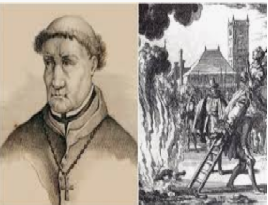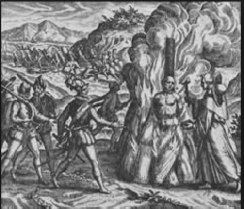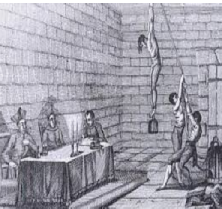|
PART 1 T O P I C |
|
|
|
|
|
|
|
|
|
|
|
|
|
|
|
|
|
|
|
CLICK BUTTON |
|
|
|
|
|
|
|
|
|
|
|
|
|
THE INQUISITION AND THE |
|
|
|
|
JewishWikipedia.info
HOW DID THE SPANIISH INQUISITION WORK
When the Inquisition opened an investigation in an area, inquisitors typically would offer comparatively light penances to those who were willing to admit their own involvement in heresy. Those confessions were used to identify other “heretics,” who were brought before a tribunal. At this trial, the accused received no assistance to defend themselves, they were frequently ignorant of the charges against them, and confessions were often obtained through coercion, confiscation of property, or torture. If the accused were found guilty, the sentence would be announced at an auto-da-fé, an elaborate public spectacle. The accused would then be handed over to civil authorities for the carrying out of the sentence.
ORGANIZATION
New World Encyclopedia
Beyond its role in religious affairs, the Inquisition was also an institution at the service of the monarchy. This does not imply, however, that it was absolutely independent of papal authority, since at various points its activities depended on approval from Rome. Although the Inquisitor General, in charge of the Holy Office, was designated by the crown, his selection had to be approved by the Pope. The Inquisitor General was the only public office whose authority stretched to all the kingdoms of Spain (including the American viceroyalties), except for a brief period (1507-1518) during where there were two Inquisitor Generals, one in the kingdom of Castile, and the other in Aragon.
The Inquisitor General presided over the Counsel of the Supreme and General Inquisition (generally abbreviated as "Counsel of the Suprema"), created in 1488, which was made up of six members named directly by the crown (the number of members of the Suprema varied over the course of the Inquisition's history, but it was never more than ten). Over time, the authority of the Suprema grew at the expense of the power of the Inquisitor General.
The Suprema met every morning, save for holidays, and for two hours in the afternoon on Tuesday, Thursday and Saturday. The morning sessions were devoted to questions of faith, while the afternoons were reserved for cases of sodomy, bigamy and witchcraft.
Below the Suprema were the different tribunals of the Inquisition, which were, in their origins, itinerant, installing themselves where they were necessary to combat heresy, but later being established in fixed locations. In the first phase, numerous tribunals were established, but the period after 1495 saw a marked tendency towards centralization.
In the kingdom of Castile, the following permanent tribunals of the Inquisition were established:
1482 In Seville and in Cordoba.
1485 In Toledo and in Llerena.
1488 In Valladolid and in Murcia.
1489 In Cuenca.
1505 In Las Palmas (Canary Islands).
1512 In Logroño Navarre.
1526 In Granada.
1574 In Santiago de Compostela.
There were only four tribunals in the kingdom of Aragon: Zaragoza and Valencia (1482), Barcelona (1484), and Mallorca (1488).[20] Ferdinand the Catholic also established the Spanish Inquisition in Sicily (1513), housed in Palermo and Sardinia. In Sicily, the Inquisition functioned until March 30, 1782, when it was abolished by king Ferdinand IV. It is estimated that 200 people were executed during this period. In the Americas, tribunals were established in Lima, Peru, and in Mexico City (1569) and, in 1610, in Cartagena de Indias (present day Colombia).
COMPOSITION OF THE TRIBUNALS
Initially, each of the tribunals included two inquisitors, a calificador, an alguacil (bailiff) and a fiscal (prosecutor); new positions were added as the institution matured.
The inquisitors were preferably jurists more than theologians, and, in 1608, Philip III even stipulated that all the inquisitors must have a background in law. The inquisitors did not typically remain in the position for a long time: for the court of Valencia, for example, the average tenure in the position was about two years.[21] Most of the inquisitors belonged to the secular clergy (priests, rather than members of the religious orders), and had a university education. Pay was 60,000 maravedíes at the end of the fifteenth century, and 250,000 maravedíes at the beginning of the seventeenth century.
The fiscal was in charge of presenting the accusation, investigating the denunciations and interrogating the witnesses. The calificadores were generally theologians; it fell to them to determine if the defendant's conduct constituted a crime against the faith. Consultants were expert jurists who advised the court in questions of procedure. The court had, in addition, three secretaries: the notario de secuestros (Notary of Property), who registered the goods of the accused at the moment of his detention; the notario del secreto (Notary of the Secreto), who recorded the testimony of the defendant and the witnesses; and the escribano general (General Notary), secretary of the court.
The alguacil was the executive arm of the court: he was responsible for detaining and jailing the defendant. Other civil employees were the nuncio, ordered to spread official notices of the court, and the alcalde, jailer in charge of feeding the prisoners.
In addition to the members of the court, two auxiliary figures existed that collaborated with the Holy Office: thefamiliares and the comissarios (commissioners). Familiares were lay collaborators of the Inquisition, who had to be permanently at the service of the Holy Office. To become a familiar was considered an honor, since it was a public recognition of limpieza de sangre—old Christian status—and brought with it certain additional privileges. Although many nobles held the position, most of the familiares many came from the ranks of commoners. The commissioners, on the other hand, were members of the religious orders who collaborated occasionally with Holy Office.
One of the most striking aspects of the organization of the Inquisition was its form of financing: the Inquisition depended exclusively on the confiscaciones of the goods of the denounced. Not surprisingly, many of those processed were rich. The situation was open to abuse, as shown in the memorial that a converso from Toledo directed to Charles I:
Your Majesty must provide, before all else, that the expenses of Holy Office do not come from the properties of the condemned, because if that is the case, if they do not burn they do not eat.[22]
Functioning of the inquisition
The Inquisition operated in conformity with Canon Law; its operations were in no way arbitrary. Its procedures were set out in various Instrucciones issued by the successive Inquisitor Generals, Torquemada, Deza and Valdés.
ACCUSATION
The first step was the Edict of Grace. Following the Sunday mass, the Inquisitor would read the edict: it explained possible heresies and encouraged all the congregation to come to the tribunals of the Inquisition to "relieve their consciences." They were called Edicts of Grace because all of the self-incriminated who presented themselves within a period of grace (approximately one month) were offered the possibility of reconciliation with the Church without severe punishment. This was effective, and many voluntarily presented themselves. Self-incrimination, however, was not sufficient; one also had to accuse all one's accomplices. As a result, the Inquisition had an unending supply of informants. With time, the Edicts of Grace were substituted by the Edicts of Faith, which made no offer of painless reconciliation.
Denunciations were anonymous. Defendants had no way of knowing the identity of their accusers.[23] This was one of the points most criticized by those who opposed the Inquisition (for example, the Cortes of Castile, in 1518). In practice, false denunciations were frequent, resulting from envy or personal resentments. Many denunciations were for absolutely insignificant reasons. The Inquisition stimulated fear and distrust among neighbors, and denunciations among relatives were not uncommon.
DETENTION
After a denunciation, the case was examined by the calificadores, who job was to determine if heresy was involved, followed by detention of the accused. In practice, however, many were detained in preventive custody, and situations of lengthy incarcerations occurred—lasting up to two years—before the calificadores examined the case.[24]
Detention of the accused entailed the "preventive sequestration" of his or her property by the Inquisición. This property paid for procedural expenses, and the accused's own maintenance and costs. Often the relatives of the defendant found themselves in outright misery. This situation was only remedied following instructions written in 1561.
The entire process was undertaken in complete secrecy. The accused were not informed about the accusations levied against them. Months, even years could pass before the accused knew why they were locked up. The prisoners remained isolated, and, during this time, they were not allowed to attend mass nor receive the sacraments. The jails of the Inquisición were not worse than those of civil society, and occasionally they were even much better. Some prisoners died in prison, as was frequent at the time.
THE TRIAL
Inquisition torture chamber
The inquisitorial process consisted of a series of hearings, in which both the denouncers and the defendant gave testimony. A defense counsel was assigned to the defendant—a member of the tribunal itself—whose role was simply to advise the defendant and to encourage him or her to speak the truth. The prosecution was directed by the fiscal. Interrogation was done in the presence of the Notary of the Secreto, who meticulously wrote down the words of the accused (the archives of the Inquisition, in relation to those of other judicial systems of the era, are striking in the completness of their documentation). To defend himself, the accused had two possibilities: abonos (to find favorable witnesses) or tachas (to demonstrate that the witnesses of accusors were not trustworthy).
To interrogate the criminals, the Inquisition used torture, but not in a systematic way. It was applied mainly against those suspected of Judaism and Protestantism, beginning in the sixteenth century. For example, Lea estimates that between 1575 and 1610 the court of Toledo tortured approximately a third of those processed for heresy.[25] In other periods, the proportions varied remarkably. Torture was always a means to obtain the confession of the accused, not a punishment itself. It was applied without distinction of sex or age, including children and the aged.
The methods of torture most used by the Inquisition were garrucha, toca and the potro. The application of the garrucha, also known as the strappado, consisted of suspending the criminal from the ceiling by a pulley with weights tied to the ankles, with a series of lifts and drops, during which arms and legs suffered violent pulls and were sometimes dislocated.[26]. The toca, also called tortura del agua, consisted of introducing a cloth into the mouth of the victim, and forcing them to ingest water spilled from a jar so that they had impression of drowning.[27] The potro, the rack, was the instrument of torture used most frequently.[28] The assertion that "confessionem esse veram, non factam vi tormentorum" (the confession was true and free) sometimes follows a description of how, presently after torture ended, the subject freely confessed to his offenses.[29]
Some of the torture methods attributed to the Spanish Inquisition were not used. For example, the "Iron Maiden" never existed in Spain, and was a post-Reformation invention of Germany. Thumbscrews on display in an English museum as Spanish were recently argued to be of English origin. The “Spanish Chair,” a device used to hold the victim while the soles of their feet were roasted, did exist in Spain during the period of the Inquisition but it is uncertain whether it was actually used.
Once the process concluded, the inquisidores met with a representative of the bishop and with the consultores, experts in theology or canon law, which was called the consulta de fe. The case was voted and sentence pronounced, which had to be unanimous. In case of discrepancies, the Suprema had to be informed.
Sentencing
The results of the trial might be:
- The defendant could be acquitted. In actual practice, acquittals were very few.
- The process could be suspended, in which the defendant went free, although under suspicion, and with the threat that their process could be continued at any time. Suspension was a form of acquittal without admitting specifically that the accusation had been erroneous.
- The defendant could be penanced. Considered guilty, he had to abjure publicly of his crimes (de levi if it was a misdemeanor, and de vehementi if the crime were serious), and condemned to punishment. Among these were the sambenito, exile, fines or even sentence to the galleys.
- The defendant could be reconciled. In addition to the public ceremony in which the condemned was reconciled with the Catholic Church, more severe punishments existed, among them long sentences to jail or the galleys, and the confiscation of all their property. Also physical punishments existed, such as whipping.
- The most serious punishment was relaxation to the secular arm, that implied burning at the stake. This penalty was frequently applied to impenitent heretics and those who had relapsed. Execution was public. If the condemned repented he was garroted before giving his body to the flames. If not, they were burned alive.
- Frequently, cases judged in absentia, or in which the accused died before the trial finished, the condemned were burned in efigie.
The distribution of the punishments varied much over time. It is believed that sentences of death were frequent mainly in the first stage of the history of the Inquisition.
THE
INCREDIBLE
STORY OF THE JEWISH PEOPLE



THE SPANISH INQUISITION LEGAL SYSTEM
